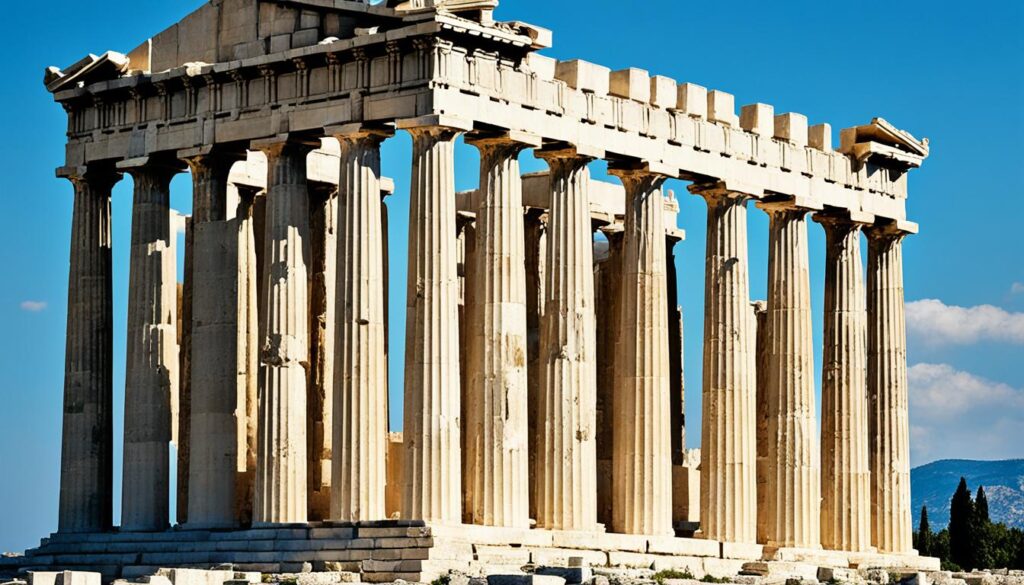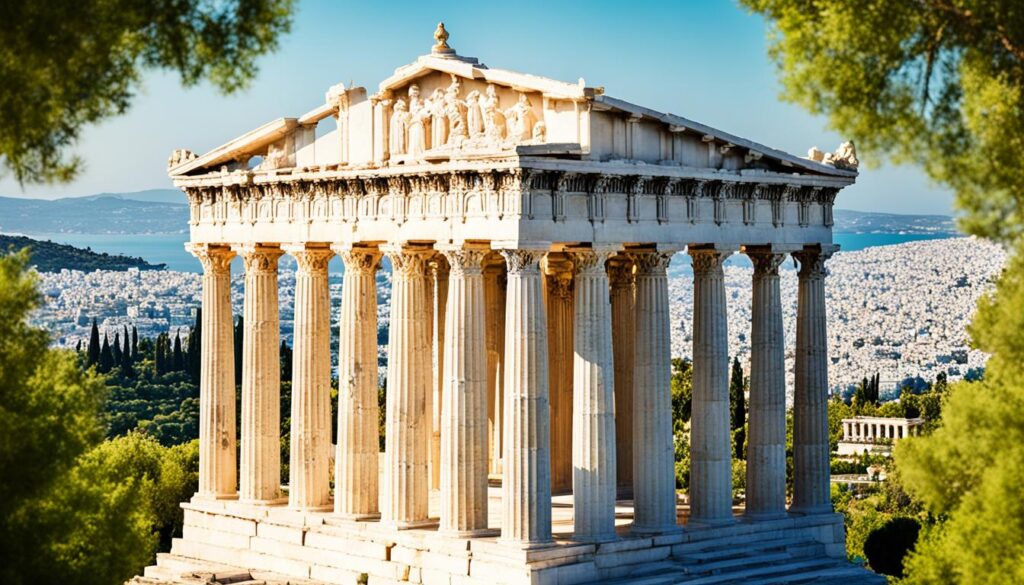The Parthenon sits atop the Acropolis in Athens, Greece. It’s seen as a masterpiece of ancient Greek architecture. It’s a symbol of the achievements and values of classical Greek civilization. This temple, built in the 5th century BC, has lasted through time.
It shows the skill of ancient Greek architects and artisans. The Parthenon is the peak of Athens’ culture and knowledge. Its design, with the Doric order and beautiful sculptures, shows the Athenians’ love for their goddess Athena and democracy.
The Parthenon’s legacy still influences how we see ancient Greek civilization today. It’s a key place for those wanting to learn about Greece’s cultural past.
Introducing the Parthenon: A Masterpiece of Classical Architecture
The Parthenon sits atop the Acropolis in Athens, Greece. It’s a true masterpiece of classical Greek architecture. Built between 447 and 438 BC, under Pericles, it shows the skill of ancient Greek builders.
This temple is big, well-proportioned, and full of detailed sculptures. It’s a perfect example of classical architecture. The design shows the ancient Greeks’ love for balance and perfection.
The Parthenon’s columns, pediments, and metopes are all made with great care. They prove the Parthenon’s high status in classical Greek architecture.
The Parthenon means more than just its looks. It symbolizes Athenian power, democracy, and culture. It’s seen as one of the most important ancient Greek landmarks.
It still stands on the Acropolis, showing the lasting impact of classical Greek culture. The Parthenon’s beauty and history continue to capture our imagination.
The Parthenon’s Historical and Mythological Significance
The Parthenon in Athens is more than just a stunning building. It’s a key part of ancient Greek history and mythology. Built in the 5th century BC, it was a temple dedicated to Athena, the city’s patron goddess.
The Birth of Athena and the Panathenaic Festival
Legend says the Parthenon is where Athena was born. She came to life from Zeus’s head after he swallowed her mother, Metis. Every year, the Panathenaic Festival celebrated her birth. It was a big event that showed off Athens’s culture and power.
The Parthenon as a Symbol of Athenian Democracy
The Parthenon was also a symbol of Athenian democracy. The temple and the festival were paid for by the city. This showed Athens’s strength and its role as a center of culture and politics in ancient Greece.
Architectural Marvels: The Parthenon’s Design and Construction
The Parthenon sits atop the Acropolis in Athens, a symbol of ancient Greek architecture. Its design shows the skill of ancient Greek builders and sculptors. The Doric order is at the heart of the Parthenon’s beauty. This style is known for its simple yet elegant columns and friezes.
The Doric Order and Classical Proportions
The Parthenon uses the Doric order, with its strong, fluted columns and simple capitals. This creates a sense of balance and harmony. The temple’s design follows classical architecture, making it visually striking and harmonious.
The Parthenon Sculptures: Masterpieces of Ancient Greek Art
The Parthenon’s sculptures are a key part of its beauty. They are seen as masterpieces of ancient Greek art. The sculptures on the temple show the skill and creativity of ancient Athenian artists.
The Parthenon’s design, with its Doric order and classical proportions, is amazing. Its sculptures add to its beauty. Together, they make the Parthenon a true wonder of the ancient world.
Cultural Wonders: The Parthenon’s Enduring Legacy
The Parthenon has stood on the Acropolis of Athens for centuries. It has deeply influenced ancient Greek culture and art. This temple is a symbol of ancient Greek greatness and has inspired many.
Its design has shaped architecture for centuries. The Parthenon’s beauty, with its columns and sculptures, has influenced many buildings. It shows the greatness of ancient Greek culture.

Scholars and fans still celebrate the Parthenon’s impact. It was important in ancient Athens and now is a UNESCO World Heritage Site. The Parthenon continues to inspire and amaze people everywhere.
The Parthenon in Modern Times: Restoration and Preservation
The Parthenon has seen many changes over the years. Modern efforts have focused on restoring and preserving it. Since the 19th century, many projects have aimed to keep the Parthenon safe for the future.
Restoration work has tackled damages from natural disasters and human actions. Earthquakes, wars, and even using the Parthenon for gunpowder storage harmed it. So, it needed fixing to look as good as new.
In 1987, the Acropolis, with the Parthenon, became a UNESCO World Heritage Site. This honor highlighted the Parthenon’s importance and the need to keep it safe. Experts from all over the world have worked together to protect it while keeping its history intact.
Now, the Parthenon shows the hard work of those who restored it. When you visit Athens, you can see the Parthenon’s beauty and its lasting impact on the city’s culture.
The Parthenon as a Source of Inspiration
The Parthenon’s legacy goes far beyond its ancient roots. It has inspired architects, designers, and artists for centuries. Its classical style, with perfect proportions and elegant design, has shaped many buildings worldwide.
Influence on Architecture and Design
The Parthenon has amazed people for thousands of years. Its beauty and importance can be seen in buildings from neoclassical to modern. Architects aim to copy the Parthenon’s elegant look and balance in their work.
The Parthenon’s impact isn’t just in architecture. It has also influenced artists, fashion designers, and product designers. Its beauty and design continue to inspire today, making it a key work of classical architecture.

The Parthenon is a beloved landmark that inspires many. Its timeless beauty and lasting impact on design touch people worldwide. It remains a true architectural masterpiece.
The Parthenon and Tourism in Athens
The Parthenon is now a top spot for tourists in Athens, pulling in millions yearly. It’s a key part of the Acropolis tour, making it a must-see for visitors. This place is a key part of Athens’ charm.
The Parthenon stands out with its big size, beautiful design, and deep history. It’s a top cultural spot in Athens. This makes it a dream trip for those wanting to dive into the city’s rich culture.
Visiting the Acropolis: A Bucket-List Experience
Going up the Acropolis and seeing the Parthenon is a moment many remember. The temple’s size and beauty are stunning. It sits on a hill, making it even more impressive.
Visitors can see the detailed sculptures and feel connected to ancient Athens. It’s like stepping back in time. This visit is often the best part of their Athens trip, making the Parthenon a key cultural spot.
Seeing the Acropolis and the Parthenon is unforgettable. It’s a chance to experience ancient Greek history. This trip leaves a strong impression on everyone who goes.
The Parthenon in Popular Culture
The Parthenon in Athens has always caught the public’s eye. It’s a key part of popular culture in many ways. From movies to school books, its lasting impact is celebrated worldwide.
Its unique design and deep history make it a favorite spot for many films. Classics like “My Big Fat Greek Wedding” and “The Clash of the Titans” feature it. It’s also seen in TV shows, books, and art, making ancient Greek culture more familiar to us.
Its role in media shows how important the Parthenon is to us. It stands as a symbol of Greek culture and history. The Parthenon’s image keeps drawing people in, proving its status as a timeless icon.






